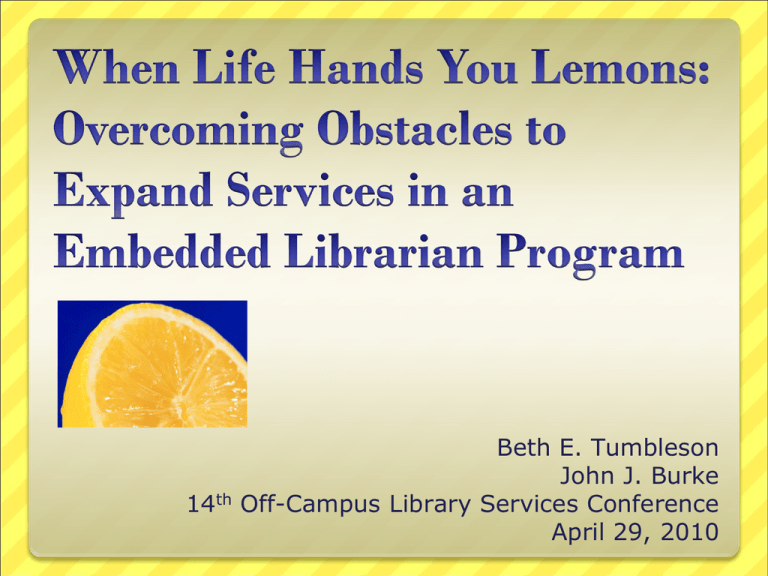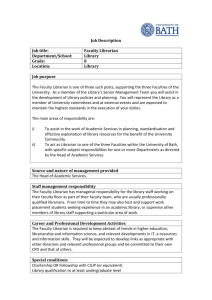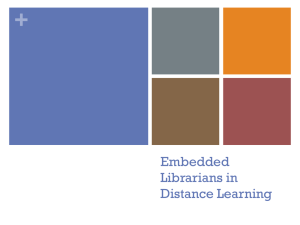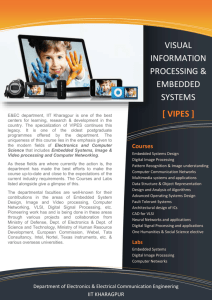When Life Hands You Lemons: Overcoming Obstacles to
advertisement

14th Beth E. Tumbleson John J. Burke Off-Campus Library Services Conference April 29, 2010 To Make Course-related research Easier Immediate Relevant Goal of Embedded Librarianship Embedded Librarianship Addresses Observed Shift in Usage Reference Questions Down Confirms Customized Content in CMS Is the Right Approach Library Website is Not Primary Research Starting Point Steven Bell observes: “Put simply, the library portal as we know it today is unsustainable. It, along with a host of other indicators such as declines in reference questions and shifts from print to e-resources, signals that for academic libraries a ‘let’s just keep doing business as usual’ mentality is a sure path to obsolescence.” “The Library Web Site of the Future?” Inside Higher Ed. 2009. Doubling Web-based courses New 4 year degree: Bachelor of Integrative Studies Online Registered Nurse Bachelor’s Completion Program Expanding from 2 to 3 regional locations Inspired at 13th OCLS Conference Campus Flowering in 2008 Embedded Librarian Program Launched, Spring 2009 University Regional Campus Open-access, Commuter Campus Off-Campus, Online, & Traditional Courses Upper & Lower Division, All Disciplines Virtual Library Open 24/7 Customized Content within Familiar CMS ORIGINAL PILOT, SPRING 2009 Participants 3 Embedded Librarians & 10 Faculty Reaching 19 sections of 13 different courses Serving 272 students THIRD SEMESTER, SPRING 2010 2 Embedded Librarians & 14 Faculty Reaching 24 sections of 17 different courses Serving 500 students SECOND SEMESTER, FALL 2009 2 Embedded Librarians & 11 Faculty Reaching 19 sections of 11 different courses Serving 265 students Embedded Librarianship: Marketing Campaign Individual Consultations to Determine Needs Creation of Customized Content Captivate Screencasts Research Databases Links Research Strategies Handouts CONTENT Workings Located on Embedded Librarian Page Located by Assignment INTERACTIONS Announcements Emailed to Class Discussion Board Comments Individual Emails, Telephone Calls, Drop-Ins Research Consultations Classroom Instruction Expanded Blackboard Embedded Librarianship 2009 LibGuides - Interactive, Online Subject Guides Video on Demand Scanning Electronic Reserves F2F Classroom Instruction as requested Embedded Librarian Tour BIS 401 (Hybrid) Decision Making, Integrative Studies BTE 105 (Online) Marketing ECO 131 Economic Perspectives on Inequality in the United States ENG 215/313 Technical Communications ENG 490 Literature of the Celtic Tiger HST 386 Race in U.S. History NSG 430 (Online) Nursing Care Aggregates: Families and Communities PSY 111 Introduction to Psychology Staff Layoffs, Budget Cuts, & Administrative Reorganization Reduced Staffing National Recession State of Ohio Budget Cuts 1st Time Ever Layoffs @ 200 Year Old University Half-time Classified Staff Position Cut Public Services Librarian Leaves; Position Frozen Budget Cuts Statewide Public University System Budget Cut University Budget Reduced by 7% during the Recession & $10 Million over 2 Years OhioLINK Budget Reduced by State Subscriptions to Databases threatened Administrative Reorganization Miami Regionals System – 3 Locations As Single Academic Unit Search for Dean of Regional Campuses Miami Middletown Interim Dean Miami University Provost Search OhioLINK Interim Executive Director New State Librarian Progress Report December 1, 2009: “Lessons Learned: How College Students Seek Information in the Digital Age” Thought-provoking Findings: “Librarians were tremendously underutilized by students.” Instructors coach students through research process. Librarians charged to initiate dialogue with faculty to close the growing divide. Leap Into Action to Support Academic Achievement. Librarian-Faculty Collaboration through Blackboard Addresses this Gap Students Do Use Online Scholarly Research Databases @ 84% Online Public Access Catalog @ 78% Ask a Librarian @ 12% Students Need Help With: “Big picture context” “Information-gathering context” Narrowing topics Finding relevant resources Sorting through too many results Evaluating credibility of sources used Preferred Research Styles LIBRARIANS FAVOR Thoroughness STUDENTS FAVOR Brevity Consensus Currency Efficiency Assessing Embeddedness At end of each semester (Spring 2009 to present) Formal web-based surveys: Faculty members Students Informal discussions among librarians Faculty Results – Fall 2009 16 questions – 5-point Likert scale 54.5% of faculty responded All faculty would: Agree collaboration in course was favorable Repeat the experience with future classes Recommend embedded service to their colleagues Two-thirds saw improvement in current students’ research behavior (when compared to that of previous semesters) Faculty Results – Fall 2009 Strengths: Introduced new library resources to students Reinforced instructor’s expectations for research E.L. impacted design of research assignments Coverage of course-specific resources Students chose more sophisticated search strategies Areas for improvement: More coverage of web site evaluation methods Regular updates of technology breakdowns or interface changes Increase reminders of citation resources Student Results – Fall 2009 11 questions, mostly 5-point Likert scale 5.7% response rate Positive student reactions: Viewed embedded librarian resources (87%) Used new databases or websites in research (73%) Would like an E.L. in future classes (73%) Found the E.L. helpful to have (67%) Student Results – Fall 2009 Areas for improvement: Contacted the E.L. for assistance (27%) Satisfied with assistance received (47%) E.L. resources made research easier/less frustrating (47%) Many students did not discover/use E.L. resources until end of semester Need to increase promotion of resources/services among students Student Results – Fall 2009 Placement of resources: 67% wanted resources linked next to assignments (71% in Spring 2009) Communication preferences: Email was first choice of 73% of students (80% in Spring 2009) Trends from Spring to Fall 2009 Student response rate stagnant at 6%; overall increase in positive responses Students twice as likely to contact the E.L. (12% Spring to 27% Fall) Less satisfied with help from E.L. (63% Spring to 47% Fall) Less satisfied with E.L. resources (65% Spring to 47% Fall) Sustaining Practices From Despair.com Assessment Key to shaping E.L. services Every semester – students and faculty Further assessment development: Compare faculty and student perceptions in E.L. classes and F2F instruction classes Compare student performance on research assignments in E.L. and non-E.L. courses Distance Learning Development Creative spark to create content Builds talents and methods that impacts embedded assistance for all types of classes Synergy of instructional methods Collaboration Among Librarians Community of embedded practice Work with other libraries at MU: LibGuides Drawing from online tutorial collections: Animated Tutorial Sharing Project (http://ants.wetpaint.com) Collaboration Beyond the Library University and campus units Marketing and financial support: Center for Teaching and Learning Inspiration: Center of Online Learning Technology support: Educational Technology Coordinator New Library Services Distance learning course support (other than embedded librarianship) Scanning items for faculty (e-reserves and beyond) Video on Demand Copyright and plagiarism consultations Persist in Marketing Reference Adoption of services takes time Embedded classes as marketing arena Email, instant messaging, and text Research consultations Collaboration with Faculty Connect library services to class assignments and outcomes Spontaneous interventions Eventual impact on assignment design Spread of information literacy in coherence with course content Commit to Embed If you believe . . . Change focus of library staff Student interaction and course support Do whatever it takes The Future Increased participation and new courses Altered work focus Adding a librarian Continuing to understand limits and move beyond them Our integral mode of delivering library resources and services Presentation available at http://tinyurl.com/OCLS2010








